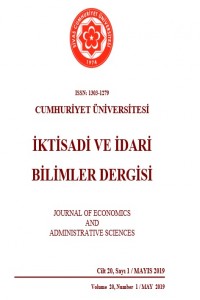Abstract
Ülkelerin arasındaki ticaretin nitelik değiştirdiği günümüz
ekonomisinde, artık daha çok ürün üreten ve ihraç eden ülkeler değil, daha
sofistike ürün üretip ihraç eden ülkeler rekabetten galip çıkabilmektedir. Bu
da ekonomilerde yapısal dönüşüm kavramını ön plana çıkarmaktadır. Yapısal
dönüşüm ile birlikte düşük verimliliğe sahip tarımsal ürünlerden daha yüksek
verimliliğe sahip olan sanayi ve hizmet sektörlerine geçiş gerçekleşmektedir.
Son dönemlerde bu yapısal dönüşümü yansıtabilen bir değişken olarak ‘ekonomik
kompleksite’ kavramı kullanılmaktadır. Bu ilişkiden hareketle bu çalışmada,
Avrupa Birliği üyesi olan Orta ve Doğu Avrupa ülkelerinin ve Türkiye’nin
ekonomik kompleksite düzeyleri üzerinde tarım, imalat ve hizmet sektörlerinin
katma değerlerinin etkisi incelenmektedir. Çalışma sonucunda, Slovakya ve
Slovenya’da imalat ve hizmet sektörlerinin; Çek Cumhuriyeti’nde ise hizmet
sektörünün ekonomik kompleksite düzeyi üzerinde anlamlı ve pozitif bir etkisi
olduğu bulgusu elde edilmiştir. Buna karşılık, Letonya, Estonya ve Türkiye’de
her üç sektörün katma değerinin de ekonomik kompleksite düzeyi üzerinde negatif
etkisi olduğu sonucuna ulaşılmıştır.
References
- CAN, Muhlis ve Buhari DOĞAN (2017), “The Effects of Economic Structural Transformation on Employment: an Evaluation in the Context of Economic Complexity and Product Space Theory”, Handbook of Research on Unemployment and Labor Market Sustainability in the Era of Globalization, IGI Global.
- DE BACKER, Koen and Norihiko YAMANO (2007), “The Measurement of Globalisation Using International Input-Output Tables”,OECD Science, Technology and Industry Working Papers, (Report No. 2007/08), OECD Publishing, Paris.
- FERRAZ, Diogo, Herick Fernando MORALLES, Jessica Suarez CAMPOLI, Fabiola Cristina RIBERIO DE OLIVEIRA and Daisy Aparecida do Nascimento REBELATTO (2018), “Economic complexity and human development: DEA performance measurement in Asia and Latin America”, Complexidade Economica e Desenvolvimento Humano: uma analize a partir do DEA.
- FORTUNATO, Piergiuseppe and Carlos RAZO (2014), “Export sophistication, growth and the middle-income trap”, Transforming Economies – Making Industrial Policy Work for Growth, Jobs and Development, ILO, 267-287.
- GALA, Paulo, Igor ROCHA and Guilherme MAGACHO (2018), “The structuralist revenge: economic complexity as an important dimension to evaluate growth and development”, Brezilian Journal of Political Economy, Vol.38; 219-236.
- GÖÇER, İsmet (2013), “Ar-Ge harcamalarının yüksek teknolojili ürün ihracatı, dış ticaret dengesi ve ekonomik büyüme üzerindeki etkileri”, Maliye Dergisi, Vol.165; 215-240.
- HADRI, Kaddour and Eiji KUROZUMI (2012), “A simple panel stationary test in the presence of serial correlation and a common factor”, Economic Letters, Vol.115, 31-34.
- HARTMANN, Dominik, Miguel R. GUEVARA, Cristian JARA-FIGUEROA, Manuel ARISTARAN and Cesar A. HIDALGO (2017), “Linking economic complexity, institutions and income inequality”, World Development 93, 75-93.
- HAUSMANN, Ricardo, Cesar A. HIDALGO, Sebastian BUSTOS, Michele COSCIA, Sarah CHUNG, Juan JIMENEZ, Alexander SIMOES and Muhammed A. YILDIRIM (2011), The atlas of economic complexity mapping paths to prosperity, Center for International Development at Harvard University.
- HIDALGO, Cesar A. (2009), “The dynamics of economic complexity and the product space over a 42 year period”, Center for International Development at Harvard University, CID Working Paper, No: 189.
- HSIAO, Cheng and M. Hashem PESARAN (2004), “Random coefficient panel data models”, IZA Discussion Paper, No. 1236.
- JINN, Brenda Cheah Wenn and Mohd Shazwan SHUHAIMEN (2018), “Complexity and growth: Malaysia’s position and policy implications”, Central Bank of Malaysia Economics Department.
- PAN, Chia-l, Tsangyao CHANG and Yemane WOLDE-RUFAEL (2015), “Military spending and economic growth in the Middle East countries: bootstrap panel causality test”, Defence and Peace Economics, Vol.26, No.24 , 443-456.
- PESARAN, M. Hashem (2004), “General diagnostic tests for cross section dependence in panels”, CWPE, No: 0435.
- POI, Brian P. (2003), “From the help desk: Swamy’s random-coefficient model”, The Stata Journal, Vol.3, No.3, 302-308.
- SIMIONESCU, Mihaela (2018), “What drives economic growth in some CEE countries?”, Studia Universitatis Economic Series, Vol. 28, No.1, 46-56.
- STOJKOSKI, Viktor and Ljupco KOCAREV (2017), “The relationship between growth and economic complexity: evidence from Southeastern and Central Europe”, MRPA Paper, No: 77837.
- SWAMY, P.A.V.B. (1970), “Efficient inference in a random coefficient regression model”, Econometrica, Vol.38, No.2, 311-323.
- YERDELEN TATOĞLU, Ferda (2013), İleri panel veri analizi Stata uygulamalı, 2. Baskı, İstanbul: Beta.
- World Economic Forum (2018), The global competitiveness report, Eds. Klaus Scwab.
- World Trade Organization (2018), World trade statistical review 2018, [https://www.wto.org/english/res_e/statis_e/wts2018_e/wts2018_e.pdf], Erişim tarihi: 08.01.2019.
- https://data.worldbank.org/indicator/NY.GDP.PCAP.PP.CD Erişim tarihi: 06.01.2019.
- https://comtrade.un.org/data/ Erişim tarihi: 06.01.2019.
- https://data.worldbank.org/indicator/NV.AGR.TOTL.ZS Erişim tarihi: 06.01.2019.
- https://data.worldbank.org/indicator/NV.IND.MANF.ZS Erişim tarihi: 06.01.2019.
- https://data.worldbank.org/indicator/NV.SRV.TOTL.ZS Erişim tarihi: 06.01.2019.
- https://atlas.media.mit.edu/en/profile/country/tur/ Erişim tarihi: 09.01.2019.
Details
| Primary Language | Turkish |
|---|---|
| Journal Section | Research Article |
| Authors | |
| Publication Date | May 31, 2019 |
| Submission Date | January 11, 2019 |
| Published in Issue | Year 2019 Volume: 20 Issue: 1 |
Cumhuriyet University Journal of Economics and Administrative Sciences is licensed under a Creative Commons Attribution-NonCommercial 4.0 International License (CC BY NC).

